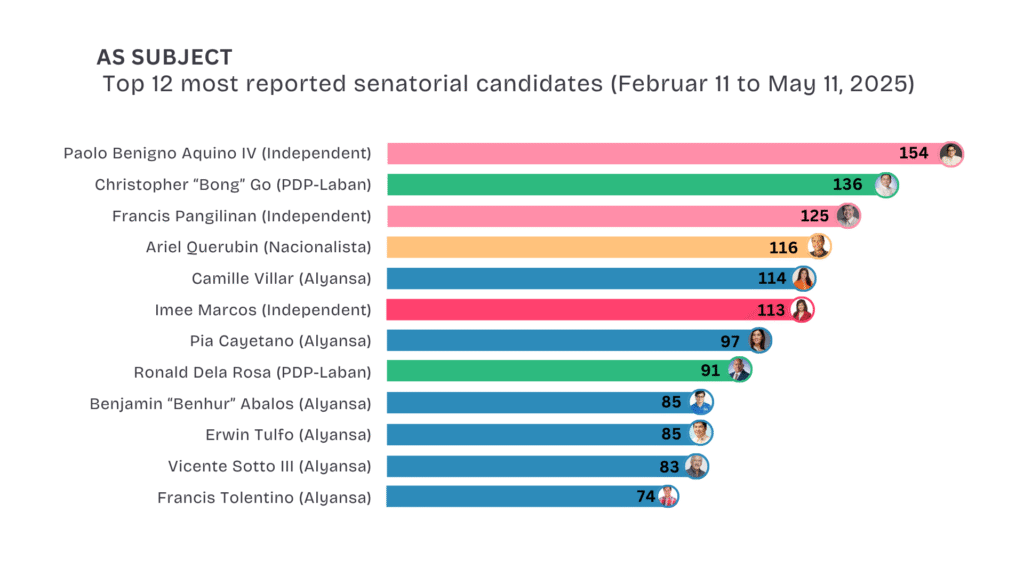Free TV Election Reporting: Small Shifts, Familiar Shortcomings
Content Analysis of the 2025 Elections coverage, February 7 to May 11, 2025
MIDTERM ELECTIONS may lack the drama of presidential contests, but they are no less crucial as a democratic exercise. These contests serve as an opportunity to check the direction of the incumbent administration, steer national and local policy to new directions and re-energize public service that can impact citizens more directly.
Media coverage must reflect this significance with coverage that commits to providing as much information that helps the public assess how well or how poorly the current administration has been doing, call attention to lagging projects and other failures in public office. As in every election, the media must share in the burden of the undertaking, collecting and sharing information about the candidates seeking public office. The failure to engage citizens in the political exercise is a failure of the media’s assigned responsibility.
Primetime television displayed modest shifts in its coverage of the May 2025 elections but remained stuck in old habits. Compared to the past, media outlets did cast a wider net to be able to feature more candidates than in previous election cycles. But bad habits persisted. TV news continued to prioritize established political personalities, campaign spectacle, and controversy. The competition for senate seats sidelined local races that play the vital role of ensuring grassroots governance and representation. There was minimal discussion of policy issues, programs and platforms.
Overview
CMFR reviewed and analyzed primetime news coverage on four major free TV networks: GMA-7’s 24 Oras and 24 Oras Weekend; ABS-CBN’s TV Patrol and TV Patrol Weekend; TV5’s Frontline Pilipinas and Frontline Pilipinas Weekend; and NewsWatch Plus’ NewsWatch Now (no weekend program) from February 11 to May 11, 2025.
The three-month campaign period yielded 743 election-related reports. Coverage favored the senatorial contest with 387 reports or 52.09 percent. House of Representatives and party-list groups, 34 reports or 4.58 percent. Local races gained only 48 reports or 6.46 percent.
Coverage focused overwhelmingly on campaign rallies and personality-driven stories. The Alyansa para sa Pagbabago (Alyansa) slate, endorsed by President Ferdinand Marcos Jr., enjoyed the most visibility during the first week of the campaign period, with all 12 candidates prominently featured. In the succeeding weeks, even lesser-known candidates received airtime. But overall, coverage was typically superficial, offering little context or insight into their characters, their platforms, and their competencies. Overall, media did not veer away from the familiar campaign trail.
Themes
Campaign sorties dominated coverage at 202 reports or 27 percent. Political controversies and election law were the second and third most dominant themes, with 124 or 16.69 percent and 123 reports or 16.55 percent, respectively.
From campaign trail to controversies
While campaign activities remained a staple in news reports, political controversies commanded coverage. Most of the reports relied on reactive soundbites, with candidates often interviewed for position or their opinion on unfolding issues.
The March 11 arrest of former President Rodrigo Duterte by the International Criminal Court (ICC) dominated primetime news coverage from that day until the end of the campaign period.
The event triggered a spike in politically charged reports, describing opposing views on the ICC taking custody of the former president. The incident projected Duterte allies in the news; raising their public presence, particularly Senators Ronald “Bato” dela Rosa and Imee Marcos, who were among Duterte’s most vocal defenders in the press.
The arrest did more than dictate headlines. It re-directed public attention, holding it long enough to define voter sentiment and re-shape the outcome for the race.
Following the incident, public opinion polls showed higher ratings for several candidates of the PDP-Laban, the party endorsed by Duterte, in turn led to increased media coverage.
The publicity surrounding the arrest benefitted Senator Bong Go who climbed from second place to lead the senatorial field, overtaking the media personality, Erwin Tulfo of the Alyansa slate. Dela Rosa rose from the 7th–14th range to as high as 2nd–3rd, while Rodante Marcoleta moved from the 22nd–24th bracket into the 12th–18th range.
Other controversies that gained media attention were Duterte and Marcos exchanging sly remarks about each other’s senatorial slates early in the campaign (February); Imee’s decision to leave the Alyansa and run as an independent (March); and Vice President Sara Duterte’s endorsement of Imee Marcos and Camille Villar (April).
Surge in election violations
From March 31 through May 11, coverage began to shift toward election preparations and conduct. Reports highlighted the Commission on Elections (Comelec)’s logistical readiness and enforcement of campaign regulations. However, much of the focus centered on violations of election laws, particularly those involving the proper posting of campaign materials, premature campaigning, and the new anti-discrimination provisions introduced under Comelec Resolution No. 11116.
Resolution No. 11116 marked a significant development by prohibiting candidates from making discriminatory remarks against individuals from vulnerable sectors, including those based on gender, disability, and other marginalized groups. Violations of this provision received notable attention in the final weeks of the campaign period, with several local candidates confronted with charges. One high-profile case resulted in the disqualification of Pasig congressional candidate Christian “Ian” Sia for making lewd and body-shaming comments during a campaign sortie.
Missed opportunities for policy and voter education
Although policies were mentioned during campaign rallies, media coverage did not explore nor analyze these in any significant manner. The formula proved the force of the news conventions in articles that gave only as much to give basic information about where the candidate was and what the candidate said.
Only 15, or just 2 percent, of the 743 reports addressed policy issues. Debate coverage was minimal, and voter education efforts remained scarce. So far, there has been little effort made to fulfill the journalist pledge in 2022 to provide accurate, reliable, and essential information that will empower voters and encourage public discussion and debate.
CMFR notes that most voter education efforts were conducted online and only briefly featured in primetime as teasers or promotional segments, which diminished their impact.
Most covered
The surprise performance of two independent candidates may be linked their visibility in the news which they gained by conducting vigorous campaigns.
Paolo Benigno “Bam” Aquino IV was the most covered candidate with 154 reports, followed by Go with 136, Francis Pangilinan with 125, and Ariel Querubin with 116. Since campaign sorties largely dictated senatorial coverage, those who campaigned the most received the most exposure. Notably, the top four most-covered candidates were not from the administration-backed slate.
Nevertheless, several Alyansa candidates still dominated overall coverage with Camille Villar (114), Pia Cayetano (97), Benhur Abalos (85), Erwin Tulfo (85), Tito Sotto (83), and Francis Tolentino (74) were among the top 12 most covered.
Go (136) and Dela Rosa (91) were the most visible among PDP-Laban or Duterte-backed candidates.

Most covered vis-à-vis Election Results
Coverage was tied to the campaign sorties and the candidates capacity to hold these events. Those who held the sorties were covered more, including those who won their senatorial bids. Six Alyansa candidates succeeded. PDP-Laban bets Go and Dela Rosa also secured seats. Independents Aquino and Pangilinan who were lagging in public opinion polls received ample media coverage because of their vigorous campaigns.
In contrast, Rodante Marcoleta, whose campaign and candidacy were not widely covered, won a seat. Two factors may have helped his win: The endorsement of VP Sara Duterte and his affiliation with the Iglesia ni Kristo and its organized vote.
Most quoted
Go was the most frequently quoted candidate, appearing in 60 reports, followed by Aquino with 57, Tolentino with 50, and Marcos with 47. Querubin and Pangilinan were also among the top, quoted in 42 and 41 reports respectively.
Aquino, Pangilinan, and Querubin were primarily quoted based on remarks made during campaign events.
Go was often quoted in connection with his survey rankings, his comments on political controversies, including Duterte’s arrest, and his statements during campaign sorties.
Imee Marcos was quoted in reports involving several controversies: her departure from the Alyansa slate, her Senate hearing questioning the legality of Duterte’s arrest, and her endorsement by VP Sara.
Tolentino’s media exposure surged in the final weeks of the campaign, largely due to the Senate committee’s hearings he held on the alleged use of local troll farms to spread China narratives in the West Philippine Sea.
Media’s role in democratic engagement
The 2025 midterm elections highlighted ongoing challenges to the understanding of media’s role in promoting a more informed and knowledgeable selection of public leaders. The impact of social media has been cited, but does it work for all those who deploy their campaign resources on this platform?
CMFR highlights the more comprehensive inclusion of candidates is a sign of a progress. But the lack of reporting on candidates for local office and the campaigns on the ground add to the highly national focus of the major media that exclude so much of what is happening on the ground and the real life problems of voters. This heightens the alienation that divides the different communities and may deepen the lack of national consensus on shared issues and concerns. At this point, the separation among Filipinos run across economic lines, but regional-geographic divisions remain forceful.
Policy matters minimized
Coverage gave paramount importance to color, some spectacle and personality as drivers of electoral reporting.
The 2025 midterm elections did not exploit the news values of policy analysis. The range of issues that burden citizens is broad enough. The obvious ones include, among others, the high cost of living, lack of affordable housing, infrastructure that favors car owners rather than public commuters. Such policy-oriented content should be part of the regular news agenda so citizens can decide for themselves how government provides for their needs through projects or programs. At election time, such reports can serve as quick checks on how candidates stand on these concerns.
Lack of information about candidates
One obvious finding is the lack of information about the public record of work or performance of candidates. Independently curated by the media fulfilling its watchdog function, such objective data would go a long way to help citizens asses the worthiness of those seeking public office.
Perhaps, it is time for the broadcast industry to review their options for transforming electoral coverage to become more focused on voters and their need. Studio heads should challenge themselves and search for new ways that radio talk programs take up electoral issues even between elections. This includes the examination of the Omnibus Election code in order to update and amend its provisions as necessary.
As a key democratic institution, as a community involved in citizen education, news media organizations must resist the temptation inherent in news conventions to amplify color, controversy and empty campaign noise. To stay in this place, is to abdicate the responsibility to provide for informed citizenship.
The constitutional protection of press freedom signifies the paramount importance of what the press or news media provide, the information that citizens need to discuss, to debate, to access and to exchange views so they can responsibly fulfill their duties as citizens, primarily to vote wisely.
New voters, new force
The midterm results forced academics and other expert communities, including public opinion pollsters, to review the status quo in the field of endeavor. Journalists must do the same. The challenge comes with the opportunity for growth. Journalists need to check the validity of the news conventions that have so long governed the news enterprise. Journalism must evolve new formats that appeal and connect with the new voters who made the difference.
The time between elections provides media workers ample opportunity for reflection and reform — steps that can help media create new ways in collecting and communicating the news. | With research from CMFR Interns Alfon Cabanilla, Gimver Celis and Yana Uy.

Leave a Reply